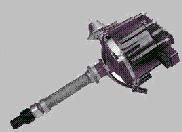 HEI Conversion
HEI Conversion

 HEI Conversion
HEI Conversion

So your ready to wire up an HEI? Heres the summary in a nutshell;
Replace the resistance wire that ran to your points system, from the fuseblock, with a 12guage wire (pink insulated if you want to remain factory compliant) and hook it up to the HEI "BAT" terminal. Thats it! Easy, Eh?
Okay, so you want more;
The points system has two wires running to the coil, one is the above mentioned resistance wire.
This wire provides reduced voltage to the coil while the engine is running. The other wire
originates from the starter R terminal (the #6 stud furthest from the engine block on the
starter solenoid). This wire provides full battery voltage to the coil during cranking only.
All your old points wiring can be eliminated. Trace both back through the wiring harness for
neat removal. The resistance wire which sources at the fuse block needs to be replaced, and the
best method is to pull off the engine compartment side of the fuse block, (DO NOT WASH OUT THE
GREASE! If you do, you will be stranded everytime things get moist outside.) and remove the lug
corresponding to the resistance wire. There is a small catch on one of the face edges of this
lug which needs to be depressed and the lug will pull through towards the "inside" of the fuse
block. It takes a bit of patience to remove it. If you want to practice first, and get a few
extra lugs (new lugs are apparently available from the GM parts counter), visit
an autowreckers and pull the engine side fuse block. And while you are there, get the HEI "Batt"
wire--you'll have a factory plug for the HEI then. (A regular female spade lug is all it takes).
I'd recommend pulling the batt wire from a Buick engine equiped car-the distributor is at the
front of the engine, and you will have a long wire to run any which way you want.
You finally have the lug in your hands with a bit of resistance wire still attached,
carefully pry open the crimp to remove the old wire. Feed your new 12 guage wire through
the fuse block (remember, the lug has to be inserted from the "inside"), strip off an
appropriate amount of insulation, gently crimp it onto the lug, and then solder it for a
secure and electrically tight connection. Reinstall the lug into its slot, steal a wipe of the
grease from the fuse block and coat your new lug. Reinstall the fuse block.
For preventative measure, hook up a voltmeter to your new ignition feed wire and check for 12 volts
in the run, and start posistions. Dress your wire, hook it up to your HEI, and off you go!!!
Tip #1: If your short term memory is like mine, mark, make a diagram, whatever it takes, to indicate which of the empty slots in the fuse block corresponds to the lug feeding the ignition system.
Tip#2: If you are experiencing part throttle pinging with the HEI, you probably have a 20 degree vacuum advance can. Most HEIs have a ridiculous amount of advance here, which is a detriment when you start experimenting for optimum timing. Pull the distributor cap and you will find a number stamped on the top of the support bracket near the can. This is the cans advance, it can be anything from 8 to 24 degrees. A 10 degree vacuum can is ideal. It is available from AC Delco Parts, or your dealership. Canadian AC Delco part number: D1370A
Tip#3: If you are experiencing a pinging under slight loads or going uphills (part throttle) , hook your vacuum advance to manifold vacuum, this will cut cut down on the amount of vacuum advance and hopefully rid you of the pinging. Excessive pinging will require a deeper look into your ignition timing and/or mechanical advance rates.
Thought #1: Ported Vacuum or Manifold Vacuum? Manifold vacuum is the choice of hot rodders, ported the choice of the factory. Depending on what level of modifcations you have done to your engine, your driving style, and your vehicles characteristics its a point of debate. Each presents its own set of advantages and disadvantages. My suggestion is to just try both and observe how your engine behaves for your driving style.
Thought #2: Do you want to clean out even more wires from the engine compartment? Purchase a "One Wire" regulator for your alternator. Obviously, this only applies to those of us with the 10SI unit. Any ACDelco parts counter should have these. They are a "marine" part, if the parts guy is having a difficult time locating it. The one wire regulator is good upto 100amps.
FYI #1: For those looking to make thier own HEI for a non-GM application, the HEI is available in 4, 6 and 8 cylinder versions. 4 and 6 cylinder units typically use an external coil. Most 8 cylinder HEIs have the coil integrated into the cap. Mid to late 80's F-body vehicles had an slim HEI w/external coil, BUT these are not stand-alone units (no vacuum advance, timing is computer controlled).
FYI #2:If you have a Ford vehicle and desire an HEI, there is a company which sells an HEI head on a Ford shaft. Check the back of any 4x4 magazine for the ad.
Remember to employ all safety precautions when working on any vehicle.
This information is only intended as an overview and may not include all the necessary
information, data, or facts to complete the swap.
Remember, every vehicle is unique, and research for your particular vehicle is recomended.

This Page Created By Alexander M. Bilan (lead.foot@usa.net)
All Rights Reserved
December 26, 1996
Revision 2.3 July 1, 1997